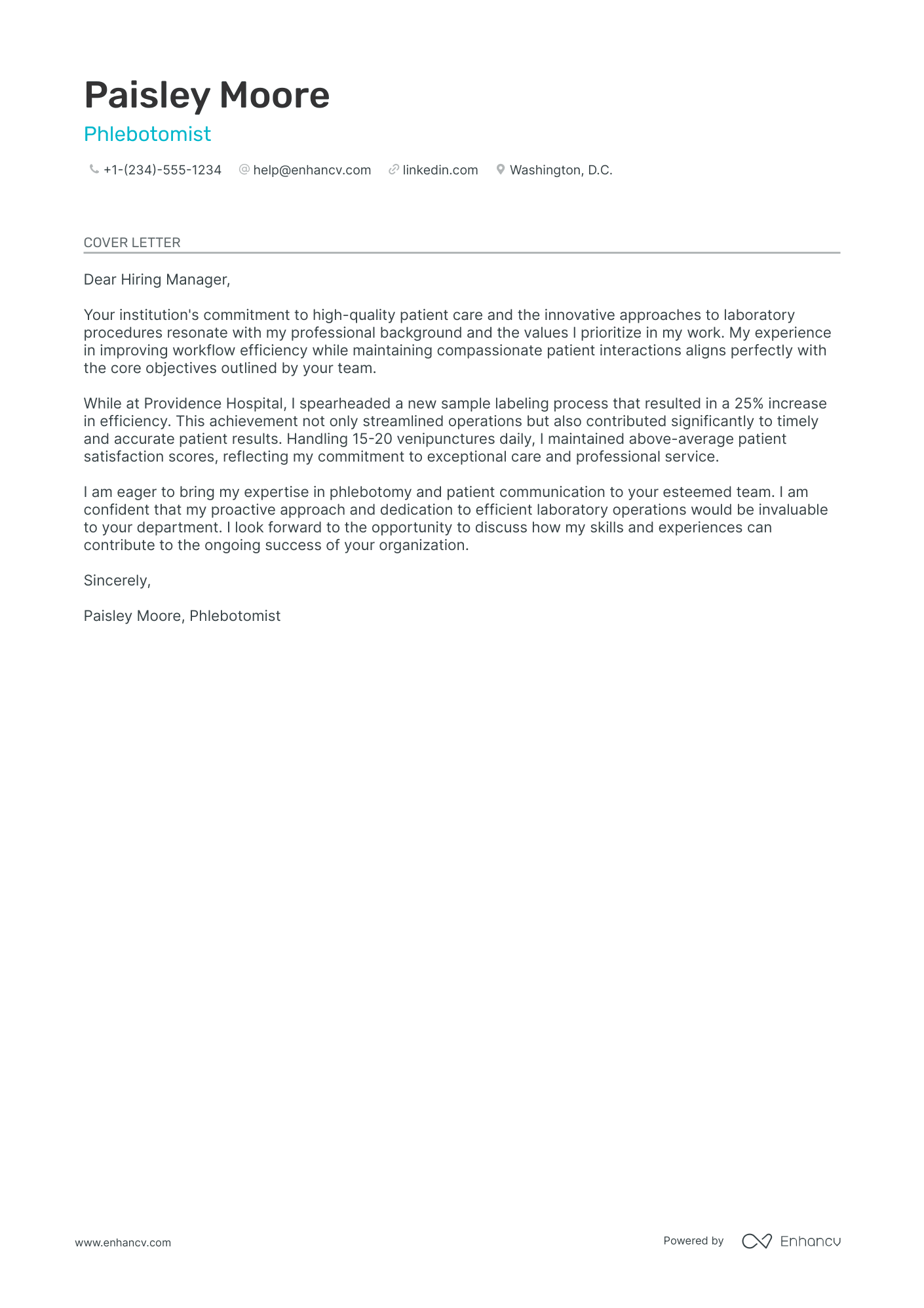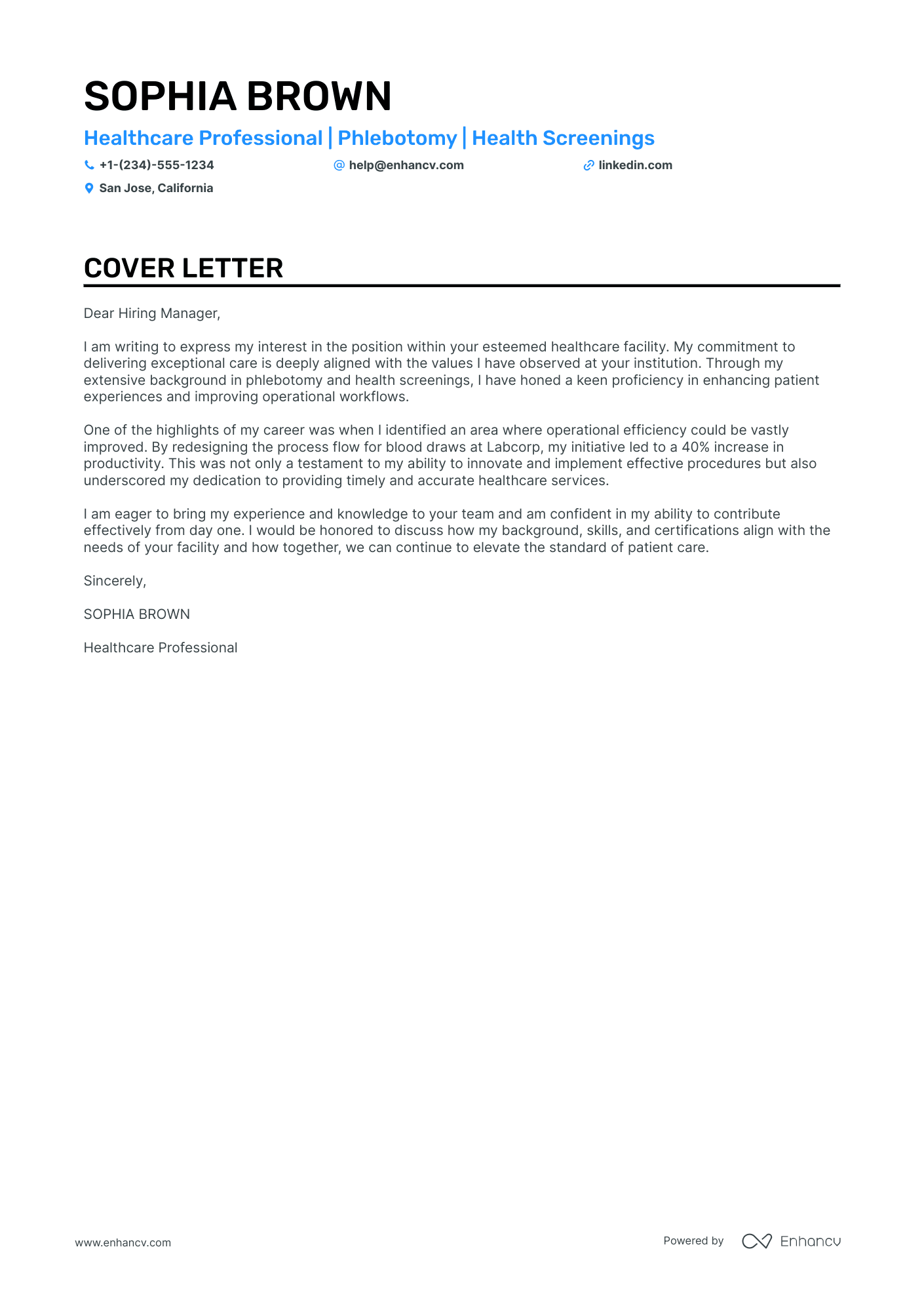Embarking on your phlebotomist career, you've polished your resume and started applying for jobs, only to hit a common snag: the daunting cover letter. Instead of simply echoing your resume, let's craft a one-page narrative that showcases your most shining professional achievement. In this guide, we'll steer clear of clichés and maintain a formal tone to help you stand out. Your phlebotomist cover letter will become a compelling story that captivates hiring managers, leaving them eager to learn more about you.
- Some inspiration from other professionals' job-winning cover letters;
- The best structure and format for your phlebotomist cover letter;
- Insights on how to write about your best achievement to stand out;
- A creative twist on your phlebotomist cover letter intro.
Upload your phlebotomist resume to Enhancv's AI, which will quickly scan and prepare a job-winning cover letter for you.
If the phlebotomist isn't exactly the one you're looking for we have a plethora of cover letter examples for jobs like this one:
- Phlebotomist resume guide and example
- Nursery Worker cover letter example
- Patient Service Representative cover letter example
- General Dentist cover letter example
- Special Needs Nanny cover letter example
- Pharmacist cover letter example
- Psychologist cover letter example
- Aesthetic Nurse cover letter example
Drop your resume here or choose a file.
PDF & DOCX only. Max 2MB file size.
Phlebotomist cover letter example
Joseph White
Indianapolis, Indiana
+1-(234)-555-1234
help@enhancv.com
- Highlighting past achievements such as the implementation of a new patient data management system showcases the ability to lead and innovate, which is critical for a Phlebotomist looking to distinguish themselves as a beneficial addition to a healthcare team.
- Emphasizing the reduction of administrative errors and increased patient data security directly relates the candidate's experience to improved patient care and operational excellence, which are top priorities in a healthcare setting.
- Showing a willingness to further discuss how one's background, skills, and certifications align with the department's needs demonstrates both eagerness and an understanding of the role's requirements, suggesting a tailored approach to the application.
What are the basics of the design or format of your phlebotomist cover letter?
To start, here's a reminder for you: the Applicant Tracker System (or software that is used to assess candidate profiles), won't be reading your phlebotomist cover letter.
Recruiters enjoy reading phlebotomist cover letters with a standardized format that uses:
- the same font as the resume (e.g. modern ones like Raleway or Volkhov are prefered over the clichéd Times New Roman or Arial);
- single spacing to keep the content concise and organized (this is all ready for you in our cover letter templates);
- a one-inch margin to wrap around the text, like in our cover letter builder;
- PDF as a file format, as it allows your design (and visual element) to stay the same.
Finally, we can't go on without mentioning the key sections of your phlebotomist cover letter.
In the top one-third, make sure to include a header (with your contact information, name, role, and date), a salutation, and an introduction.
Next, follows the heart and soul of your phlebotomist cover letter or its body.
End your phlebotomist cover letter with a closing paragraph and, if you wish, a signature.
Overwhelmed by cover letters? Our free cover letter generator lets you make one in seconds based on your resume.
The top sections on a phlebotomist cover letter
Header: This section should include the phlebotomist's contact information, professional email, and the date, ensuring the recruiter knows who is applying and how to respond.
Greeting: A tailored greeting addresses the hiring manager by name, reflecting the phlebotomist's attention to detail and personal touch, qualities important in patient-facing roles.
Introduction: The introductory paragraph should capture the recruiter's attention by briefly stating the phlebotomist's experience and enthusiasm for the role, emphasizing their commitment to patient care and safety.
Body: This section is where the phlebotomist highlights relevant experiences, such as proficiency in blood collection techniques, patient comfort strategies, and knowledge of laboratory procedures, to demonstrate their qualifications and readiness for the job.
Closing: In the closing portion of the cover letter, the phlebotomist should express their eagerness to contribute to the healthcare team, thank the recruiter for considering their application, and include a call to action, like an invitation to discuss their skills in an interview.
Key qualities recruiters search for in a candidate’s cover letter
- Proficiency in venipuncture and capillary puncture techniques: Essential for ensuring patient comfort and sample integrity.
- Knowledge of blood collection equipment and storage protocols: Critical for maintaining safety and compliance with laboratory standards.
- Excellent patient communication skills: Important for calming nervous patients and clearly explaining procedures.
- Attention to detail and accuracy in labeling and tracking specimens: Vital to prevent mix-ups and ensure correct test results.
- Experience following strict hygiene and sanitation protocols: Necessary to prevent contamination and maintain a sterile environment.
- Ability to work efficiently under pressure: Important for handling high volume draw times and urgent sample requests with professionalism.
How to address hiring managers in your phlebotomist cover letter greeting
Goodbye, "Dear Sir/Madam" or "To whom it may concern!"
The salutation of your phlebotomist cover letter is how you kick off your professional communication with the hiring managers.
And you want it to start off a bit more personalized and tailored, to catch the recruiters' attention.
Take the time to find out who's recruiting for the role (via LinkedIn or the company page).
If you have previously chatted or emailed the hiring managers, address them on a first or last name basis.
The alternative is a "Dear HR team" or "Dear Hiring Manger", but remember that a "Dear Ms. Simmons" or "Dear Simon," could get you farther ahead than an impersonal greeting.
List of salutations you can use
- Dear Hiring Manager,
- Dear [Employer's Name],
- Dear [Department Name] Team,
- Dear Dr. [Last Name],
- Dear Mr./Ms. [Last Name],
Using your phlebotomist cover letter intro to show your dedication
We know just how difficult it is to start writing your phlebotomist cover letter introduction.
There are so many great qualities you have as a professional, which one should you choose?
How about writing up to two sentences about your passion and commitment to the work you do or are set to do?
Try to describe exactly what you enjoy about the potential role.
A positive attitude from the get-go will help you stand out as a motivated phlebotomist professional.
Structuring your phlebotomist cover letter body to add more value
You've hinted at your value as a professional (this may be your passion for the job or interest in the company) in your introduction.
Next, it's time to pan out the body or middle of your phlebotomist cover letter.
When creating your resume, you've probably gone over the advert a million times to select the most relevant skills.
Well, it's time to repeat this activity. Or just copy and paste your previous list of job-crucial requirements.
Then, select one of your past accomplishments, which is relevant and would impress hiring managers.
Write between three and six paragraphs to focus on the value your professional achievement would bring to your potential, new organization.
Tell a story around your success that ultimately shows off your real value as a professional.
A sincere and original way to end your phlebotomist cover letter
When writing their phlebotomist cover letter, candidates tend to use one of these phrases, "Sincerely yours" or "I look forward to hearing from you".
Both statements show good manners, but your cover letter should end in a more actionable manner.
Write about:
- how you see yourself growing in the role/organization;
- the benefits you would bring about (you'd impress even more with tangible metrics);
- the next steps in the process (provide your availability for interviews).
Phlebotomist cover letter advice for candidates with no experience
If you're worried about writing your Phlebotomist cover letter and have no professional experience, we sure have some advice for you.
Turn recruiters' attention to your transferable or relevant skills gained thanks to your life and work experience.
Instead of writing about past jobs, focus on one achievement (whether from your volunteering experience, education, etc.) and the skills it has helped you build.
Alternatively, you could focus your Phlebotomist cover letter on your career objectives and goals. Always remember to make those relevant to the job you're applying for by detailing how you see yourself growing as part of the company.
Recruiters would be way more impressed with candidates who fit the job profile and can bring about plenty of skills and vision to the table.
Key takeaways
Writing your phlebotomist cover letter doesn't need to turn into an endless quest, but instead:
- Create an individual phlebotomist cover letter for each role you apply to, based on job criteria (use our builder to transform your resume into a cover letter, which you could edit to match the job);
- Stick with the same font you've used in your resume (e.g. Raleway) and ensure your phlebotomist cover letter is single-spaced and has a one-inch margin all around;
- Introduce your enthusiasm for the role or the company at the beginning of your phlebotomist cover letter to make a good first impression;
- Align what matters most to the company by selecting just one achievement from your experience, that has taught you valuable skills and knowledge for the job;
- End your phlebotomist cover letter like any good story - with a promise for greatness or follow-up for an interview.
Phlebotomist cover letter examples
By Experience
Entry-Level Phlebotomist
By Role













